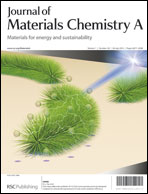Porous LiMn2O4 microspheres, which are constructed with nanometer-sized primary particles, have been synthesized by a facile method using porous MnCO3 microspheres as a self-supporting template. The LiMn2O4 microspheres were characterized by XRD, SEM and HR-TEM. The as-synthesized porous LiMn2O4 microspheres exhibit high rate capability and long-term cyclability as cathode materials for lithium ion batteries, with the specific discharge capacity of 119, 107 and 98 mA h g−1 and the corresponding capacity retention of 82, 91 and 80% for up to 500 cycles at 2, 10 and 20 C, respectively. The high rate performance and good cyclability are believed to result from the porous structure, reasonable primary particle size and high crystallinity of the obtained material, which favor fast Li intercalation/deintercalation kinetics by allowing electrolyte insertion through the nanoparticles and high structural stability during the reversible electrochemical process. The high level of Mn4+ concentration on the surface of the sample can alleviate the Jahn–Teller transition, which was triggered normally by the equal amounts of Mn4+/Mn3+ concentration on the surface of the LiMn2O4 cathode material. This good example offering extended cycle life at 20 C rate for the LiMn2O4 microspheres indicates their promising application as cathode materials for high performance LIBs.

You have access to this article
 Please wait while we load your content...
Something went wrong. Try again?
Please wait while we load your content...
Something went wrong. Try again?


 Please wait while we load your content...
Please wait while we load your content...